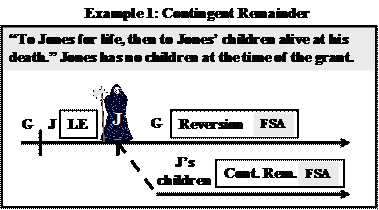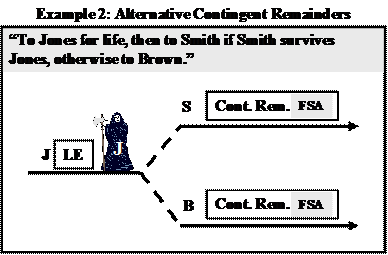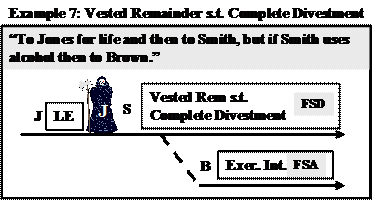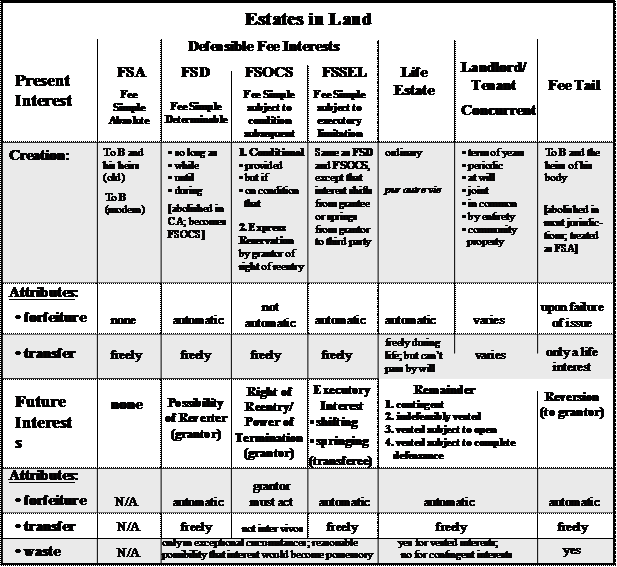OneLBriefs
Property Law Outline - Future Interests in Freehold Estates
- Future Interests retained by GRANTORS
- Reversion (PI = LE)- residual future interest left in grantor.
- Ex: G grants LE to A. G retains reversion, because he (or his heirs) will get the land after A dies.
- A reversion is alienable, devisable, and descendible.
- NOTE: If a grant gives LEs to B, then the original grantor provides that C should get property in the will, C has a reversion because he takes the place of the original grantor.
- Power of termination (PI = FSSCS)- interest goes back to grantor if condition of the grant is breached AND he exercises the power . Also called right of entry.
- Allows a grantor to terminate in interest to enforce a condition subsequent.
- Condition subsequent is when the remainder is created first, and then the condition is usually in the subsequent clause.
- Ex: "to E on condition that the property is not used as a commercial establishment, and if the property is used as a commercial establishment, R has the right to reenter and take the property."
- Note: grant must contain an express power of termination.
- Power of termination is descendible and devisable but NOT alienable.
- Property is not automatically forfeited upon breach of the condition. Original grantor must exercise power of termination.
- Possibility of reverter (PI = FSD) - arises in the grantor when he grants a determinable interest (FSD).
- Grant does not have to explicitly create the interest, because forfeiture occurs automatically when the condition is breached. Grantor does not have to act.
- Ex: "To E as long as the property is never used as a commercial establishment."
- Possibility of reverter is alienable, devisable, and descendible.
- Future interests by THIRD PARTIES/GRANTEES
- Remainder- interest in a third party that immediately follows the natural expiration of the preceding interest.
- Key is that the first interest ends naturally and is not cut short by some other event, such as violation of a condition subsequent.
- Three Categories:
- Contingent Remainder (RAP!)- Occurs if:
- The identity of the remainderman is unknown OR
- The remainder is subject to a condition precedent (condition that is part of the granting clause creating the remainder or comes in a previous clause).


- Vested Remainder- Occurs if the identity is known AND the remainder is not subject to a condition precedent. There are three types:
- If there is NO CONDITION SUBSEQUENT, then ----> Indefeasibly vested remainder.
- Ex: "To Jones for life, then to Smith."
- If THE CLASS OF GRANTEES COULD EXPAND IN NUMBER, then ----> Vested remainder subject to open (RAP!).
- Ex: "To Albert for life, then to Albert's siblings"; If Albert's parents are still alive, then the class of siblings could expand.
- Class can close in two ways:
- Class closes naturally when no new class members can be created (i.e., Albert's parents die); OR
- Class closes due to rule of convenience when the gift can be distributed and there is at least one eligible class member.
- If there are no class members at the time the grant can be distributed (i.e. Albert dies, has no siblings, and parents are still alive), then the class stays open until it closes naturally.
- Assuming the class is not already closed, a person becomes a member of the class upon conception.
- If there is a CONDITION SUBSEQUENT that could divest the remainderman of the entire interest, then ----> Vested remainder subject to complete divestment.
- Ex: "To Jones for life and then to Smith, but if Smith uses alcohol, then to Brown."

- Executory Interest (RAP!) - Occurs if the interest will ONLY follow the violation of some condition.
- Ex: To Jones, so long as no one uses alcohol on the property, and then to Smith."
- Here is no natural expiration of the first interest; the violation of a condition is the only way that Smith could get the property.
- Example problems:
- O grants "to A for life, then to B for life." Then, will gives property to C.
- B has a indefeasibly vested remainder.
- C has a reversion. C stands in the place of the original grantor (O).
- O grants "to A for life, then to B for life if B survives A, otherwise to C.
- B has a contingent remainder because there is a condition precedent (B must survive A) and because there is another option (if B doesn't survive A, C gets it).
- C has an alternative contingent remainder because C is the other option if B breaches condition precedent.
- Chart

- Classifying Remainders
- Definition: A remainder is a future interest created in someone other than the transferor that, according to the terms of its creation, will become a present estate (if ever) immediately upon, and no sooner than, the natural expiration of all prior particular estates (i.e., estates of limited duration—a life estate or a term of years) created simultaneously with it.
- Thus, there are three principal elements:
- The interest is created in someone other than the transferor;
- The interest must be capable of becoming possessory immediately upon the natural termination of the prior estate; and
- The interest must follow a life estate, term of years, or fee tail.
- Types of Remainders
- Indefeasibly Vested Remainder—To find that a person has an indefeasibly vested remainder, the following four conditions must be satisfied:
- The interest is held by a born and ascertainable person;
- The interest is certain to become possessory immediately upon the termination of the preceding estate (i.e., not subject to a condition precedent);
- The interest is indefeasible (i.e., there is no condition subsequent that will divest the remainderman); and
- The interest is indivisible (it cannot be diminished in size).
- Contingent Remainder—If conditions (i) or (ii) fail, the remainder is contingent.
- NOTE: Condition (ii) can fail in one of two ways:
- If it fails because the party does not take unless some condition precedent has been met, then the party has a contingent remainder. (E.g., "to A for life, then to A's first child," and A has not yet had any children.)
- If there is simply a gap in possession, but the party is sure to or may take sometime after the previous estate ends, the party has an executory interest (and not a remainder) (E.g., "O to A for life, then five years later to B" gives B a springing executory interest out of O's reversion; "O to A until B reaches 21, then to B" is a shifting executory interest, divesting A before the natural end of some estate.)
- Vested Remainder Subject to Complete Defeasance—Conditions (i), (ii) and (iv) are satisfied, but condition (iii) fails.
- E.g., "To A for life, then to B, but if B does not maintain the property as a farm, then to C."
- Vested Remainder Subject to Partial Defeasance (a/k/a partial divestment, or subject to open)—Conditions (i), (ii), and (iii) are satisfied, but condition (iv) fails.
- E.g., "To A for life, then to A's children." A has one child.
- Vested Remainder Subject to Complete and Partial Defeasance—Conditions (i) and (ii) are satisfied, but conditions (iii) and (iv) fail.
- E.g., "To A for life, then to A's children, but if any of A’s children go to law school, then B." A has one child.
-
Future Interest
Examples
Indefeasibly Vested Remainder
"To A for life, then to B."
Vested Remainder Subject to Open
"To A for life, then to A's children." (A has a child, B. B has a vested remainder subject to open.)
Vested Remainder Subject to Complete Divestment
"To A for life, then to B, but if B dies before A, to C." (B has a vested remainder subject to divestment by C)
Contingent Remainder
- "To A for life, then to A's children." (A has no children at time of grant)
- "To A for life, then to A's children who survive A." (A has a child, B)
- "To A for life, then to B if B reaches 21." (B is 17)
- "To A for life, then to B's heirs." (B is alive, heirs only become so at death of B)
- "To A for life, then to B if B survives A, but if B does not survive A, to C."
Executory Interest
- "To A, but if B returns from Rome, to B."
- "To A for life, then to B, but if B does not survive A, to C."
- "To A upon her marriage."